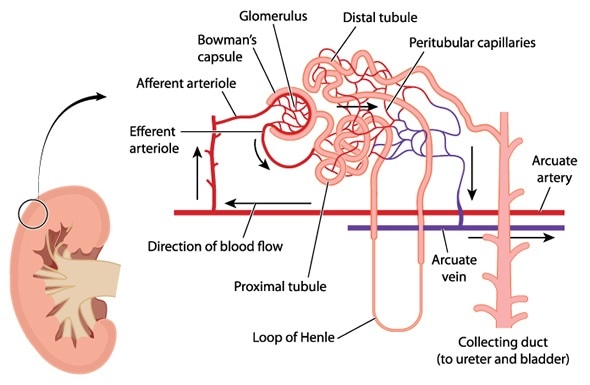How your kidneys work
Watch this video to see how filtration occurs in the kidneys.
The excretory system is the waste removal system of the body. It helps to keep our bodies clean and healthy. Use this resource to learn how the organs of the respiratory system work together to support your body's functions.
The excretory system (or urinary system) plays a critical role in removing waste from the body and helping to maintain its internal balance.
The digestive system removes solid waste from digestion, turning food materials that we can't use into faeces. The respiratory system gets rid of waste gases like carbon dioxide when we breathe out. The excretory system is different because it filters the blood. This lets us remove any extra water, salts, and toxins from the body to keep it balanced and hydrated.
The path through which this happens is called the urinary tract.

Let's explore the parts of the urinary tract.
The kidneys are bean-shaped organs that filter waste and extra substances that we don't need from our blood. We have two kidneys. They are found on either side of our spine and each is about the size of a fist.
The kidneys contain tiny filtration units called nephrons, which consist of a glomerulus (a tiny network of capillaries) and tubule. These structures work together to filter blood, reabsorb necessary substances and excrete waste.

Through the filtration process, our bodies make urine, a yellowish liquid waste. Urine can then be removed from the body by urination to get rid of toxins, and extra minerals and fluid that the body doesn't need. Read further to learn about how filtration occurs.
Ureters are two thin tubes that connect the kidneys to the bladder. They transport urine from the kidneys, where it's produced, down to the bladder for storage.
The walls of the ureters are lined with smooth muscles that contract rhythmically, helping push urine smoothly toward the bladder. This process ensures that urine flows in one direction and reduces the risk of infections.
The bladder is a muscular sac found in the lower abdomen that stores urine until it's ready to be expelled from the body. Its flexible walls stretch to hold urine and contract when it's time to pee.
Within the bladder, normal healthy urine is sterile (free of bacteria).
A healthy bladder can typically hold about two cups (or \(473\) millilitres) of urine. The bladder has sensors that tell the brain when it's full, giving you the urge to urinate.
The urethra is a tube that carries urine from the bladder out of the body during urination.
Muscles called sphincters help control the release of urine from the body.
Excretion is the process of removing waste from the body to make sure the internal environment remains balanced and healthy.

This diagram gives you an overview of the process, but let's step through it in more detail.
Important molecules like glucose, amino acids, and ions are reabsorbed into the bloodstream. This leaves only waste and excess substances in the urine.
This process primarily happens in the distal tubule of the nephron. It helps fine-tune the body's chemical balance and ensure that all unnecessary substances are removed efficiently. Secretion also plays a crucial role in maintaining pH balance and removing drugs or toxins from the body. Together with filtration and reabsorption, secretion completes the process of urine formation, readying waste for excretion.
The key components of the urinary tract and their functions are outlined in the table.
| Component | Function |
|---|---|
| Kidneys | Filter waste and excess substances from the blood, creating urine |
| Ureters | Provide a channel for urine to enter the bladder |
| Bladder | Stores urine until it is ready to be removed from the body |
| Urethra | Carries urine from the bladder out of the body |
See how well you understand the components of the excretory system and their roles with a quick quiz.